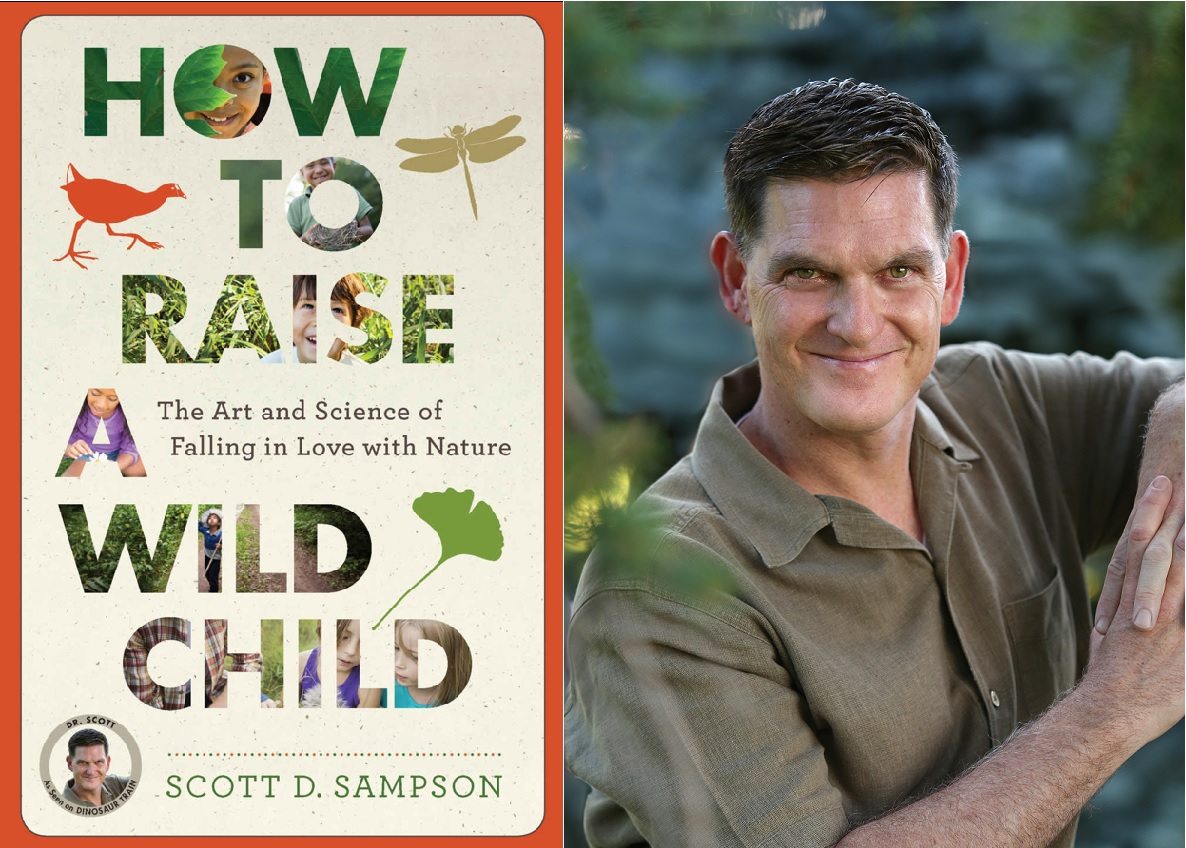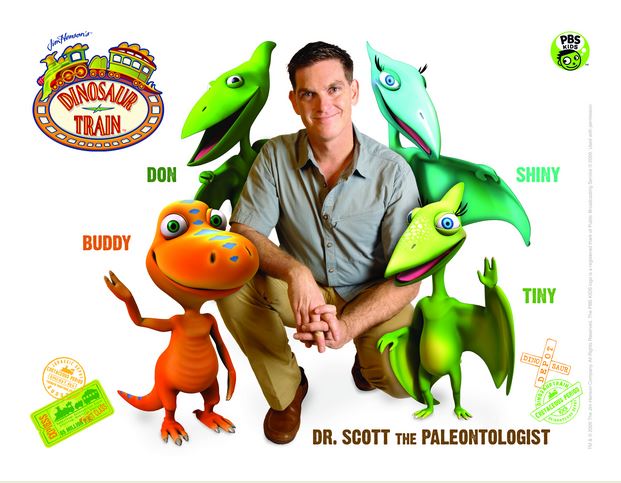If I say the name Scott D. Sampson, odds are it might not ring any bells. But if you have young kids with even the slightest interest in dinosaurs, chances are very good you’ve heard of Dr. Scott the Paleontologist. If you’ve ever seen an episode of the PBS Kids / Jim Henson show Dinosaur Train, then you’ve seen Dr. Scott. He appears at the end of every episode, talks about the science behind each story, makes connections between the prehistoric world and the more familiar world in which kids live, and ends every episode by encouraging kids to “get outside, get into nature, and make your own discoveries!”
I recently had the opportunity to chat with Scott about his new book, How to Raise a Wild Child (see my review here), the importance of getting kids connected to nature, and what parents can do about it.
We had a fantastic (i.e., long) conversation, so I’ve broken up the interview into two parts. Stay tuned for part 2, coming soon…
GeekDad: You mention that your favorite thing Rachel Carson wrote was a short essay called “Help Your Child to Wonder,” in which she shares a vision for fostering a deep connection with nature among children. She lived out the rest of her life wanting to write a book on this topic but unfortunately never had an opportunity. Was this your inspiration for How to Raise a Wild Child?
Scott Sampson: Yeah, in some ways, if I have to cite one piece of work that was an inspiration, it would probably be that piece by Rachel Carson. I found it powerful, and it just seemed to me that the book she was talking about writing was still lacking today. That we really didn’t have any book out there that talked about the process of connecting kids with nature and how that process changes as kids grow up. So I think that’s a fair statement.
GD: I imagine a lot of people know you primarily as the “face” of Dinosaur Train, and I hope that that doesn’t ever get old for you. Can you discuss briefly how that came about?
SS: Sure. Well, Dinosaur Train has been on the air now for six years, and probably about eight years ago I received a phone call from an executive at the Jim Henson Company. I’d done a bunch of television prior: I’d hosted a series on the Discovery Channel and appeared in a number of documentaries, but this phone call took me by surprise.
The executive said, “Listen, we’re thinking about doing the program on PBS about dinosaurs, and would you be interested in getting involved?” So I said, “Well, that sounds great. What’s it called?” She said, “Dinosaur Train!” And I said, “You can’t call it that!” And she said, “How come?” So I said, “Well, because I’m a paleontologist, and I’m always trying to convince people that humans and dinosaurs didn’t live at the same time. So you can’t go and stick ’em both on a train.” And she said, “Don’t worry, we’re only going to stick dinos on the train.” And I stopped, and I said, “Well, that’s just brilliant!” I mean that’s like chocolate and peanut butter if you’re 4 years old.
So Dinosaur Train is now in over 100 countries, it reaches more than 10 million households a month in the U.S., and so it’s exploded into something that’s wonderful and–I’ll be honest–when we started the project, I had no idea if a television show could encourage kids to turn off the television and go outside. But I negotiated this tagline at the end that you’ve probably heard a number of times now: “Get outside, get into nature, and make your own discoveries.” And I’m very happy and proud to report that hundreds of parents have come to me and said, “Yes, our kids get outside in part because of the show. We even use it as an excuse to get our kids outside.” So it’s a great example of how technology can be leveraged to promote the connection with nature for kids.
GD: You make a distinction between “wild nature” and other outdoor places such as parks and zoos. How are these different, and what makes the former so much more powerful?
SS: I define three different kinds of nature. One is wild nature, which is not controlled by humans. The second is domestic nature. So wild nature would obviously be wilderness at the extreme, and domestic nature is house plants and pets and vegetable gardens. And technological nature is the kind of nature you might see in a natural history museum or on a television documentary or a piece of art even.
I make the distinction because it turns out that wild nature is much more powerful at connecting kids with the natural world. The interesting point to be made, though, is that I don’t mean wilderness. The notion of wildness changes as kids grow up. A backyard with some grass and rocks can be plenty wild if you’re a preschooler. If you’re in middle childhood, say between 6-11, it might be a walk down an urban creek with trees on either side. And for teens, wildness can be a trip to the wilderness, but there’s other ways of getting it as well.
It’s also important to keep in mind that even in places with domestic nature, like vegetable gardens, there is plenty of wild nature, including all those insects and migratory birds. The key here is to get as much exposure to nearby nature as possible and have some of that nearby nature include elements of wildness. And it turns out to be dead simple to get it. Plant native plants, native plants attract native insects, those insects attract native birds and other animals. Anyone can do this in their backyard, schoolyard, courtyard, whatever.
GD: You recommend kids get outside into nature every day. That can and should be done in places close to home, but you also recommend at least an hour a day. What if that’s simply not feasible with all of the other academic and extracurricular commitments kids have? Kids today are so overcommitted.
SS: Right. Exactly. There are several obstacles that prevent this whole notion of nature connection, and one of the biggest is scheduling–that we overschedule kids compared to the way we were a generation ago when we were basically kicked outside after school. We had less homework, we had less scheduled sports, we didn’t have all the piano lessons and all that (at least many of us). So we had the time. Nowadays it’s tougher.
So what I recommend is that parents just start making a habit of getting kids out. On the book’s website, I have a challenge: The Wild Child Nature Challenge. I ask parents and other caregivers to pledge to get kids out for at least 30 minutes three times a week. I recognize that an hour a day, although great, just isn’t going to be possible for a lot of kids. Thirty minutes three times a week will make a difference. A big difference.
The way I think about this is that nature shouldn’t be thought of as leisure time–something like: if we can make it to the park on the weekend, that’s great. Rather, we should think more about nature connection the way we think about literacy. We schedule time to read to our kids every night or to have them do some reading. Getting kids outdoors, connecting with nature, is equally important given the crisis that’s going on today with both childhood and sustainability. You’ve probably seen these statistics: obesity, attention deficit, diabetes, depression. These conditions and others are skyrocketing in the current generation of kids to the point where the U.S. surgeon general said that this generation of children may be the first to have a life expectancy shorter than that of their parents.
Now nature is no panacea, but getting kids out and more active is a huge step in the right direction. And a growing mountain of studies document the fact that, in particular, unstructured–that is, free–play that is outdoors is critical for growing minds and bodies. And kids just aren’t getting it these days. So we really do need to think about how to make it become a habit to get kids outside.
GD: Parents are constantly bombarded with what’s best for their kids, what they need to emphasize, and what’s the most important. We’re constantly hearing that early exposure to science, music, languages, and art are critical to brain development. And they need to get enough exercise. And travel. And lots of books to foster a love of reading. It can get a little overwhelming. Where does a love of nature fit into everything and why should parents add it to the list?
SS: To answer that question, I would say let’s go back and look at the tenure of humanity on Earth–about 200,000 years. Most of that time was spent living in hunter-gatherer cultures: small tribes that lived in intimate contact with the natural world. Kids are born to play. Take any preschoolers, whether they’ve ever met each other or not, stick them on a playground, and they will naturally start to do imaginative, creative play. That’s what they’re built to do, and that’s what we’re not allowing them to do these days. We schedule kids so much that they don’t have that.
And the other thing kids need as they get older is some autonomy. What’s frightening these days is that some kids get to be 10 or 11 years old without having an unsupervised moment in their lives. Kids need that. As they get into middle childhood and certainly into adolescence, we need to give them autonomy so they can take risks, so they can get out there and try things out and learn the limits of their bodies and their minds and build on that. In some ways, that’s missing.
So I put nature connection right up there as one of the most important things you can do for kids. It turns out that if you do that, if you’re interested in sparking an interest in learning (science, in particular), there’s probably no better way to do that than to get kids out into nature. All kids are born with a deep sense of wonder; just watch a baby crawling around and see what it does. But by the time kids get to be about 10 or 11 years old, we tend to have beaten that sense of wonder out of them. But if we can foster that sense of wonder through provocative questions rather than just a series of answers, then that kid is set up for a lifetime of learning and for better success at school.
It turns out that kids learn to think like scientists through play. But play isn’t some trivial thing to burn off some energy, it’s critical for the growing mind. So I rank it right up there as one of the most important gifts that we can give to a child.






